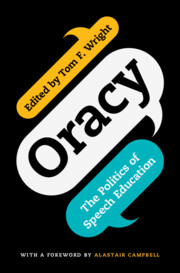Book contents
- Oracy
- Oracy
- Copyright page
- Contents
- Figures
- Tables
- Contributors
- Foreword: The Oracy That Democracy Needs
- Acknowledgements
- Introduction
- Part I Debating Oracy in the UK
- Part II Oracy in Global Context
- 7 Oracy Overseas
- 8 What Can Be Learnt from Global Traditions of Oracy?
- 9 Lessons in Oracy from the American Education System
- Part III Oracy in History and in Theory
- Index
- References
8 - What Can Be Learnt from Global Traditions of Oracy?
from Part II - Oracy in Global Context
Published online by Cambridge University Press: 23 September 2025
- Oracy
- Oracy
- Copyright page
- Contents
- Figures
- Tables
- Contributors
- Foreword: The Oracy That Democracy Needs
- Acknowledgements
- Introduction
- Part I Debating Oracy in the UK
- Part II Oracy in Global Context
- 7 Oracy Overseas
- 8 What Can Be Learnt from Global Traditions of Oracy?
- 9 Lessons in Oracy from the American Education System
- Part III Oracy in History and in Theory
- Index
- References
Summary
In "What can be learnt from global traditions of oracy?" the prominent anthropologist Karin Barber explores the intertwined nature of orality and literacy across cultures. Despite the high value placed on literacy, she observes, orality remains a vibrant skill and creative domain in many societies. Recent studies emphasize the coexistence and mutual influence of oral and written traditions, demonstrated through examples like Italian commedia dell’arte and Afghan refugee poets. The chapter focuses first on the Yorùbá culture of Nigeria, where oral traditions shape individual identities and social interactions alongside a vibrant written literature. Further examples from Kenya and the Basque country highlight how informal oral genres integrate into education, fostering creativity, language skills, and cultural preservation. Overall, the chapter underscores oracy’s educational value and cultural significance across contexts, offering insights applicable to promoting oracy skills in the UK.
Keywords
Information
- Type
- Chapter
- Information
- OracyThe Politics of Speech Education, pp. 104 - 115Publisher: Cambridge University PressPrint publication year: 2025
References
Accessibility standard: WCAG 2.2 AAA
Content Navigation
Allows you to navigate directly to chapters, sections, or non‐text items through a linked table of contents, reducing the need for extensive scrolling.
Provides an interactive index, letting you go straight to where a term or subject appears in the text without manual searching.
Reading Order & Textual Equivalents
You will encounter all content (including footnotes, captions, etc.) in a clear, sequential flow, making it easier to follow with assistive tools like screen readers.
You get concise descriptions (for images, charts, or media clips), ensuring you do not miss crucial information when visual or audio elements are not accessible.
You get more than just short alt text: you have comprehensive text equivalents, transcripts, captions, or audio descriptions for substantial non‐text content, which is especially helpful for complex visuals or multimedia.
Visual Accessibility
You will still understand key ideas or prompts without relying solely on colour, which is especially helpful if you have colour vision deficiencies.
You benefit from high‐contrast text, which improves legibility if you have low vision or if you are reading in less‐than‐ideal lighting conditions.
